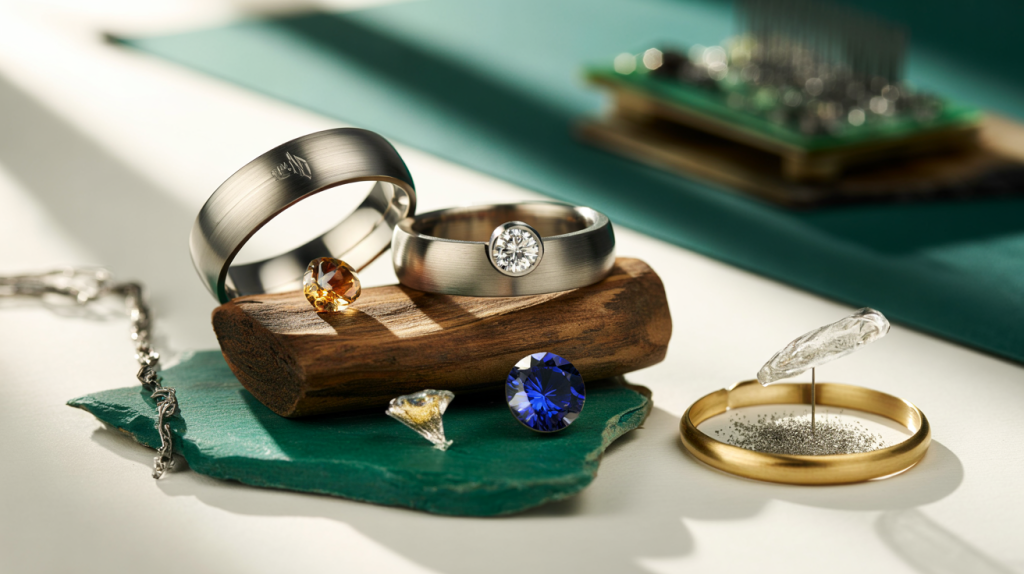Classic gold still rules display cases, yet its footprint tells a tougher story. Artisanal and small-scale gold mining is the largest source of human-made mercury emissions worldwide, according to the United Nations Environment Programme’s Global Mercury Assessment 2018. Consumers want shine without the spillover, and the market now answers with credible, durable options that look luxe and age well.
There is no single swap for every design or budget. Good news: recycled precious metals, stainless steel, titanium, and lab-grown gemstones deliver strength, style, and traceability. Recycled gold already provides roughly a quarter of total gold supply, says the World Gold Council’s Gold Demand Trends 2023, while major brands are pivoting fast. Pandora announced in 2024 that it now uses 100 percent recycled silver and gold in all jewelry, estimating about two-thirds fewer emissions compared with mined metals in its value chain.
Sustainable alternatives to gold in jewelry that actually last
Longevity matters as much as sparkle. Materials chosen for daily wear need hardness, resistance to scratches and tarnish, and safe finishes. Many shoppers start with recycled precious metals because they preserve the look and value of traditional gold pieces while dramatically cutting extraction impacts. Others prefer more rugged materials for rings or bracelets that get knocked around.
The problem most people want to solve is simple: a beautiful piece that does not hide a messy origin. That means asking where the metal came from, how the stones were produced, and whether any mine or lab can be traced. The upside is big. When recycled content replaces newly mined material at scale, upstream pollution and water use fall, and communities tied to risky extraction face less pressure.
Momentum accelerated over the past few years. The Global E-waste Monitor 2020 reported 53.6 million tonnes of electronic waste generated in 2019, containing significant precious metals by value. While recovery rates still lag, jewelers sourcing refined recycled gold and silver from certified recyclers help pull those metals back into long life on a wrist rather than a landfill.
Recycled metals and tough alloys: silver, gold, stainless steel, titanium
Recycled gold: visually identical to newly mined gold, compatible with heirloom-quality settings, and widely offered by independent ateliers. The World Gold Council’s 2023 figures show recycling supplied about one quarter of total gold that year, tightening the loop and easing pressure on new mines.
Recycled sterling silver: a cost-friendly choice for minimalist chains and bold cuffs. When properly alloyed and rhodium plated, it resists tarnish in daily wear and can be refinished over time.
Stainless steel: hard-wearing, hypoallergenic grades are easy to clean and nearly maintenance free. The International Stainless Steel Forum reports average global recycled content around 44 percent, with end-of-life recycling rates above 80 percent. That circularity keeps pieces affordable and durable.
Titanium: lightweight, skin-friendly, and remarkably strong for slim bands or contemporary earrings. It holds a satin sheen that does not fade, and it is a favorite for people with sensitive skin who want a ring that disappears on the hand until the light hits.
Lab-grown gems, moissanite and colored stones: sparkle without mining
Lab-grown diamonds exist on a spectrum. They have the same crystal structure as natural diamonds, but their footprint depends on the energy mix of the facility. Some labs now publish third-party verified life cycle data and use renewable power. That transparency matters more than the marketing tag.
Moissanite delivers bright fire at a fraction of the price. On the Mohs hardness scale reported by the Gemological Institute of America, diamond sits at 10, moissanite averages about 9.25, and sapphire at 9. Translation for everyday wear: moissanite and sapphire handle scratch-prone routines far better than glass or cubic zirconia.
Lab-created sapphire and ruby match their mined counterparts chemically, take precise cuts, and come in consistent colors without new pits in the ground. Designers lean on them for bold signet rings, baguette stacks, even bridal sets that prize punchy color over rarity.
How to buy responsibly: labels, questions and simple checks
Shoppers do not need to become metallurgists. A few quick checks reveal whether a piece respects both the planet and the wearer. Certifications are not a cure-all, but they reduce guesswork and create accountability throughout the supply chain.
A short checklist helps when comparing brands or custom orders.
- Ask for recycled content in writing for gold or silver, and the refiner’s name.
- Look for labels: Fairmined or Fairtrade Gold for responsibly mined metal, Responsible Jewellery Council Chain of Custody for traceable sourcing, SCS-007 for certified lab-grown diamonds, or ISO 14001 on facilities.
- Request a repair and resizing policy. Durable pieces deserve upkeep options.
- Check gem info: origin or lab-grown disclosure, and hardness data if daily wear is planned.
- Prefer nickel-safe alloys and PVD or rhodium finishes for skin comfort.
One caveat on lab diamonds deserves repeating. Energy-hungry reactors can erase sustainability gains when powered by coal-heavy grids. Brands that publish energy sources and third-party audits remove that doubt and set a higher bar for the rest.
For gifts and heirlooms, recycled gold in classic settings remains the easiest low-impact move. For active lifestyles, stainless steel or titanium rings take scrapes without drama and keep their price steady. And for big sparkle, moissanite or lab-created sapphire carry daily wear beautifully while staying out of mining debates. That is where jewerly quietly becomes a values choice as much as a style one.
The last piece often missing is transparency at the counter. A simple product page that lists metal origin, recycled percentage, gem type and finishing method turns an impulse buy into an informed one. When those basics show up, the alternatives to gold stop feeling like compromises and start reading like the smarter default.
